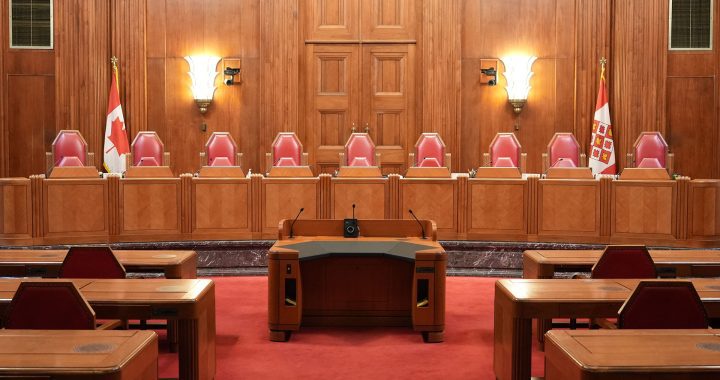The Manitoba Métis Federation, or MMF, says an injunction filed against a treaty it signed with Canada is because of a misunderstanding of Section 35 of the Canadian Constitution.
“I think that there are misconceptions out there that in the Constitution there is a hierarchy, that there are different levels of rights, and different nations have different constitutional rights, which isn’t true,” said Will Goodon, the housing minister for the MMF.
On Nov. 30, the MMF and Canada signed the Red River Métis Self-Government Recognition and Implementation Treaty. Two days later, on Dec. 2, two Dakota Nations filed an injunction against it.
Trippier Law filed a motion for an injunction on behalf of the Dakota Tipi and Canupawakpa Dakota First Nations in Manitoba. The MMF and the Attorney General of Canada are named as respondents.
The plaintiffs argue the Treaty is constitutionally invalid and that Canada and Red River Métis have “have breached their constitutional, fiduciary, and other duties, including the ongoing duty to consult the Plaintiffs,” according to the injunction notice.
They’re demanding an injunction prohibiting the MMF from making land and resource claims without consulting the Dakotas.
“The Plaintiffs are descendants of the Oceti S’Akowin Nation who have exclusively used, lived on, occupied and drew life on the Land,” the motion reads. “The Plaintiffs never agreed to cede, surrender, or extinguish their rights in the Land.”
The injunction is the Dakotas’ second legal action against the MMF this year.
On Oct. 11, they filed a lawsuit against the MMF, the province of Manitoba and Canada alleging they were excluded from land and resource consultations.
In a phone interview with APTN News, Dakota Tipi Chief Dennis Pashe said the injunction asserts their rights as Dakota people.
“It’s not any animosity or anything, it’s just that the government is neglecting Dakota people,” Pashe said. “They did give us an apology July 15th of this year, but they refuse to meet with us or are not willing to work with us to implement what that means.”
That apology was to nine Dakota and Lakota First Nations for longstanding injustice, including labelling them as ‘refugees’ and denying treaty benefits.
Crown-Indigenous Relations Minister, Gary Anandasangaree, promised to work with the Dakotas and Lakotas to develop modern treaties and agreements.
The statement of claim filed against the MMF by the Dakotas calls for a distinctions-based approach to Indigenous rights.
This approach recognizes the distinct rights, histories and legal systems of First Nations, Inuit and Métis in Canada, has been adopted in British Columbia.
Pashe argued that Canada must affirm Dakota’s historic connection to the land, which he said dates back 12,000 years.
“Who was here based on a distinctions-based process of time? Who was here 12,000 years ago, who was here a thousand, who was here, and so forth,” Pashe said.
Goodon agreed that First Nations, Métis and Inuit must be recognized as distinct people.
However, he questioned Pashe’s interpretation of the distinctions-based approach.
“Something we’ve been trying to rectify for years, and years and years is that we’re not a mixed people, we are a unique, distinct, Indigenous nation, with all the markers of a nation,” Goodon said. “In Section 35, there are three peoples mentioned, and there is no mention at all that one is above or below anyone else.”
He stressed that the Red River Métis Treaty doesn’t negate Canada’s obligations to other Indigenous communities.
“Going back to Louis Riel, when he negotiated our entry into Confederation, he made sure that in the talks was that Canada needed to sign treaties with First Nations,” Goodon said. “So, we’re going back to those days, and we still agree that Canada needs to fulfil its obligations to all Indigenous peoples.”
Dissecting the Treaty
The Red River Métis Self-Government Recognition and Implementation Treaty does not include harvesting, land or land-related rights.
Section 95 of the Treaty discusses the procedures to be taken if the treaty is found to infringe on the rights of other Indigenous peoples.
It includes a three-step dispute process involving an intergovernmental relations committee, mediation and judicial proceedings and arbitration as a last resort.
Goodon said consulting First Nations about the treaty was the Crown’s, not the MMF’s duty.
In a statement sent to APTN, Jacinthe Goulet, a spokesperson for Crown-Indigenous Relations and Northern Affairs Canada, said the “Treaty was informed by over one year of consultation and engagement with other Indigenous groups” including First Nations in Manitoba.
“This process was undertaken before the Treaty was finalized, in keeping with Canada’s constitutional obligations.”
She added that the treaty “is about the right of the Red River Métis to organize and govern themselves, and to pass laws that apply to their citizens, and which relate to their own internal affairs” and “does not include land or address harvesting or land-related rights.”
Goulet said Canada is reviewing the Notice of Motion filed by the two Dakota Nations, which it received on Dec. 2.











